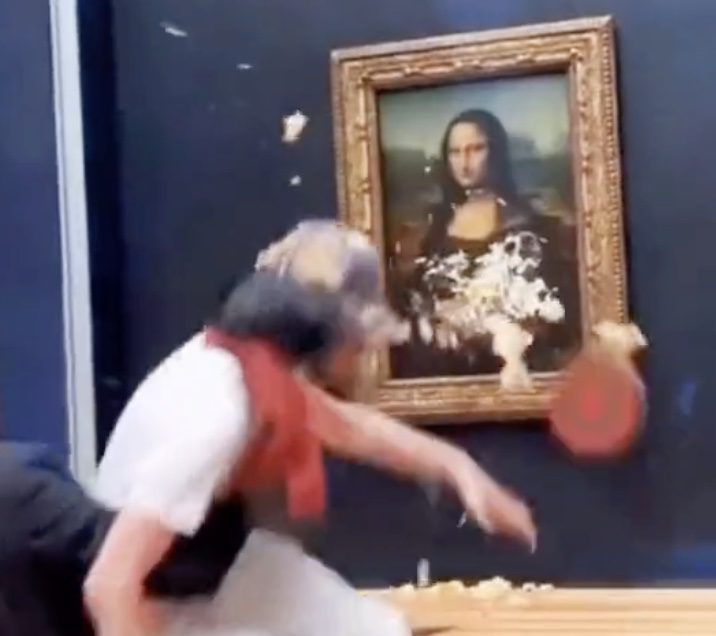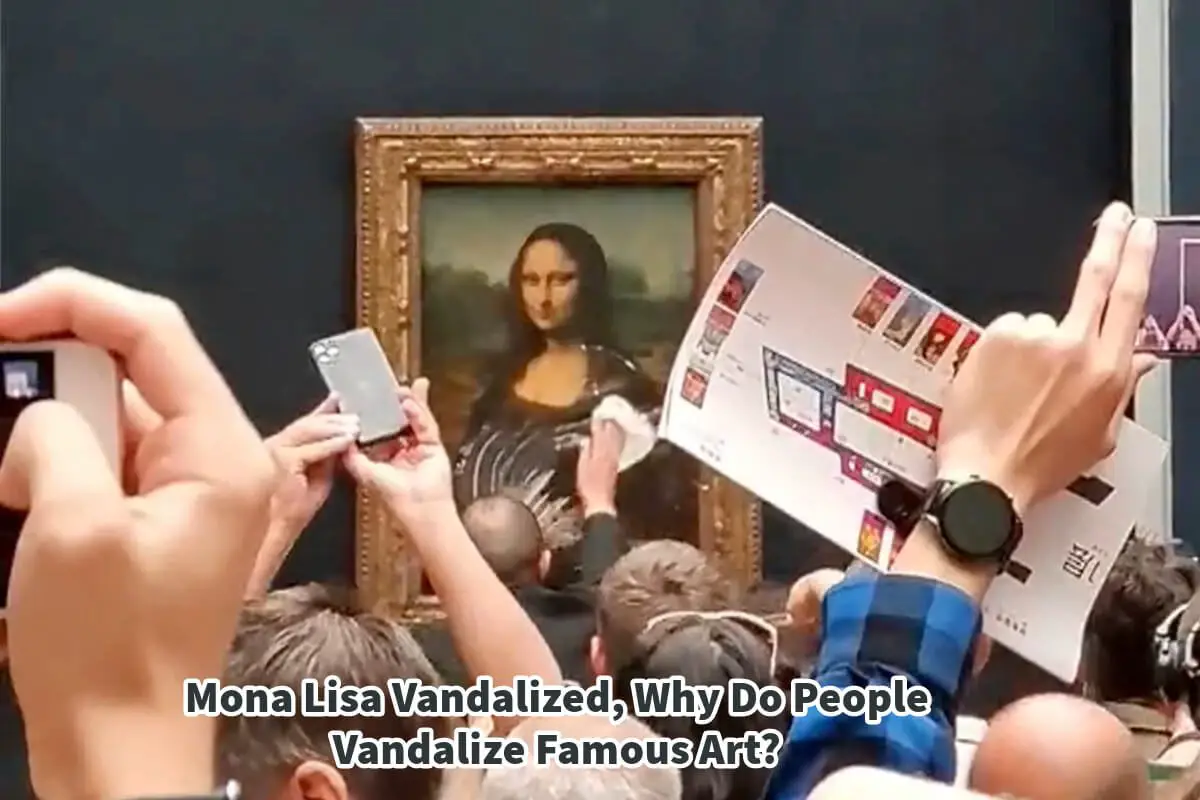While it’s true that artworks like the Mona Lisa have been the target of attempted vandalism, the Mona Lisa itself has not been “vandalized many times throughout history.”
There was one well-known instance in 1956 where it was damaged when someone threw acid at the lower part of the painting and another where a rock was thrown at it. In 2019, it was hit with a teacup, and in 2022, cake was thrown on it. However, it primarily remained unscathed thanks to extensive security measures. Read on as we go through some of the 15 reasons art like the Mona Lisa is Vandalized.
Table of Contents
- 15 Reasons Why Art Like Mona Lisa Is Vandalized
- Get Attention:
- Media Coverage:
- Publicize A Cause:
- Political Reasons:
- Personal Discontent:
- Ideological Statement:
- Economic Gain:
- Copycat Motivation:
- Psychological Issues:
- Religious Motivations:
- Ethnic Or Nationalist Reasons:
- Revenge:
- To Create A New Art Form:
- Ignorance Or Lack Of Appreciation:
- Accidental:
- 15 Reasons You Should Never Vandalize A Painting Like The Mona Lisa
- It’s Illegal:
- National Treasures:
- Ineffective Communication:
- Tarnishes Your Cause:
- Loss Of Artistic Value:
- Disrespect To The Artist:
- Security Increases:
- Diverts Public Funds:
- Induces Fear And Anger:
- Ethical Questions:
- Bad Publicity:
- Legal Consequences Across Borders:
- Damages Reputation:
- Cultural Erosion:
- Wasted Opportunity:
- Frequently Asked Questions
- Related Questions
15 Reasons Why Art Like Mona Lisa Is Vandalized
That said, vandalism of art is a phenomenon that can occur for various reasons. Here are some potential motivations behind the act:

Get Attention:
One of the quickest ways to grab public attention is by defacing something universally recognized and valued.
Media Coverage:
Vandals may hope to see their act covered in the traditional and social media, thus spreading their message or gaining notoriety.
Publicize A Cause:
Some vandals deface artworks to draw attention to political or social causes they are passionate about.
Political Reasons:
Some acts of vandalism are motivated by political agendas, either to oppose the ideas represented by the artwork or to make a more significant political point.
Personal Discontent:
The individual may be acting out of dissatisfaction with the art establishment or as a form of self-expression.
Ideological Statement:
The act can be motivated by a desire to challenge prevailing aesthetic, cultural, or social norms.
Economic Gain:
Some acts of vandalism may be motivated by the potential for financial gain, either through ransom or by damaging a work to decrease its value for a later theft.
Copycat Motivation:
Seeing other acts of vandalism can sometimes inspire others to commit similar acts, either for the thrill or similar ideological reasons.
Psychological Issues:
Some individuals may be motivated by deep-seated psychological issues that drive them to destructive behavior.
Religious Motivations:
Artwork may be vandalized because it is seen as heretical or blasphemous according to particular religious views.
Ethnic Or Nationalist Reasons:
Some vandals may target artworks to communicate ethnic or national identity.
Revenge:
Personal or professional grievances might motivate someone to vandalize an artwork.
To Create A New Art Form:
Some people believe that defacing an existing piece creates a new art form—though this controversial viewpoint is not widely accepted.
Ignorance Or Lack Of Appreciation:
Sometimes, vandalism occurs simply because the individual does not understand or appreciate the value of what they are destroying.
Accidental:
Though not precisely “vandalism” in the intentional sense, some artworks are damaged due to accidents or carelessness.
None of these reasons justify vandalism, which is illegal and destructive against shared cultural heritage.
15 Reasons You Should Never Vandalize A Painting Like The Mona Lisa
Defacing or vandalizing renowned artworks like the Mona Lisa is a destructive and controversial way to get one’s message across.

Here are 15 reasons why this is not a good idea:
It’s Illegal:
Vandalizing art is a criminal act that can result in fines, imprisonment, or other legal consequences.
National Treasures:
Works like the Mona Lisa are not just paintings; they’re cultural icons and heritage pieces that belong to everyone.
Ineffective Communication:
Vandalism often upsets people and can make them less receptive to whatever message the vandal is trying to convey.
Tarnishes Your Cause:
Any political or social cause associated with vandalism will likely be viewed negatively.
Loss Of Artistic Value:
Once vandalized, a work of art may never be fully restored to its original condition, which is a loss for all humanity.
Disrespect To The Artist:
The original artist’s work is irrevocably altered, directly affronting their artistic vision and effort.
Security Increases:
Each act of vandalism usually leads to increased security measures, which can make public art less accessible to everyone.
Diverts Public Funds:
Instead, money that could be used for other public services is spent on repair and increased security.
Induces Fear And Anger:
Such acts often create an atmosphere of tension, leading to public fear and anger, which doesn’t support any constructive dialogue.
Ethical Questions:
On a basic ethical level, destroying or damaging something that doesn’t belong to you is wrong.
Bad Publicity:
In an age of social media, the negative impact of such an act can be amplified manifold, making it even more damaging for your cause.
Legal Consequences Across Borders:
Many countries have strict laws against art vandalism and may extradite individuals for such offenses.
Damages Reputation:
The individuals involved risk damaging their reputations, making it difficult to find employment, run for public office, etc.
Cultural Erosion:
The defacing of essential works can be seen as an erosion of cultural heritage, which is often irreplaceable.
Wasted Opportunity:
The energy and motivation that drive someone to such an act could be channeled into more constructive avenues for making a point or inspiring change.
The bottom line is that there are far more effective, ethical, and constructive ways to make a point or raise awareness about a cause than by damaging art that is a shared cultural treasure.
Frequently Asked Questions
Has the Mona Lisa been vandalized many times throughout history?
No, the Mona Lisa has not been vandalized many times throughout history. While there have been a few notable instances, such as in 1956 when acid was thrown at it, and in 2019 and 2022 when it was hit with a teacup and cake, respectively, these incidents are relatively rare.
What happened during the 1956 incident of vandalism on the Mona Lisa?
In 1956, the Mona Lisa was damaged when an individual threw acid at the lower part of the painting. Fortunately, the damage was not irreversible, thanks to prompt restoration efforts.
Are there any other instances of vandalism against the Mona Lisa?
Yes, there have been other incidents, including an occasion when a rock was thrown at the Mona Lisa. However, the painting has generally been well-protected, and the damage in these instances was limited.
How did security measures prevent extensive damage to the Mona Lisa during vandalism attempts?
The Mona Lisa is heavily guarded with advanced security measures, including protective barriers and surveillance. These measures have played a crucial role in minimizing damage during attempted acts of vandalism.
When did the most recent act of vandalism occur on the Mona Lisa, and what was the nature of the incident?
In 2022, the Mona Lisa experienced an incident where cake was thrown at it. Despite the unconventional nature of the attack, the security measures in place prevented significant harm to the artwork.
Why do people attempt to vandalize famous artworks like the Mona Lisa?
Motivations for art vandalism can vary, but some individuals seek attention, protest, or express their discontent with societal norms. In some cases, mental health issues may also contribute to such actions.
What measures are taken to protect the Mona Lisa and other valuable artworks from vandalism?
Museums employ a range of security measures, including surveillance cameras, protective barriers, trained security personnel, and, in some cases, advanced technology to detect and prevent vandalism.
Have any vandals been successful in causing permanent damage to the Mona Lisa?
No, despite several attempts, no vandal has succeeded in causing permanent or irreparable damage to the Mona Lisa. The security and conservation efforts in place have proven effective in safeguarding this iconic artwork.
How do art institutions respond to acts of vandalism against famous works?
Art institutions typically respond swiftly to acts of vandalism, implementing restoration procedures to repair any damage. Additionally, legal actions may be taken against the perpetrators to discourage such behavior and protect cultural heritage.
What role does public awareness and education play in preventing art vandalism?
Public awareness and education about the importance of cultural heritage can contribute to the prevention of art vandalism. Understanding the value of artworks and the consequences of such actions can deter individuals from attempting to vandalize or damage priceless masterpieces.
Anita Louise Art is dedicated to art education, great artists, and inspiring others to find and create their art. We love art that uplifts and inspires. #ArtToMakeYouSmile! #ArtToMakeYouHappy!
If you are interested in seeing any of my art, you can find out more by clicking here. If you are interested in what inspires me and my paintings, you can discover more by clicking here.
We have a free newsletter and would love you to be part of our community; you can subscribe to the newsletter by clicking here. I would be happy to talk to you if you have any questions. You can reach me, Anita, by clicking here.
Subscribe to our Anita Louise Art YouTube Channel with great videos and information by clicking here.
Join us for our podcast “5 Minutes With Art.” Spend just 5 minutes a week with us to discover and learn about great art and artists. You can find out more about our podcast by clicking here.
Related Questions
Mona Lisa: The Most Famous Painting In The World
Painted by the legendary artist Leonardo da Vinci and completed in 1506, it is the world’s most famous and most viewed painting. However, its significance extends far beyond mere popularity. The Mona Lisa’s intriguing history, including a daring theft from the Louvre, has contributed to its enigmatic allure. Read on as we will delve into the captivating story of the Mona Lisa, exploring its artistic mastery, the mesmerizing smile, and the extraordinary events that have elevated it to iconic status in art.
By clicking here, you can learn more by reading Mona Lisa: The Most Famous Painting In The World.
Who Is Mona Lisa? Unveiling The Enigmatic Portrait
Many believe that the Mona Lisa is the portrait of Madam Lisa Giocondo. While the woman’s true identity in the painting has remained a subject of debate and speculation, it is widely believed that the Mona Lisa is a portrait of Madam Lisa Giocondo. This theory is based on the mid-sixteenth-century biography of Leonardo da Vinci by Giorgio Vasari, historical records, and circumstantial evidence.
By clicking here, you can discover more by reading Who Is Mona Lisa? Unveiling The Enigmatic Portrait.
12 Years Leonardo Painted Mona Lisa’s Lips, Facts Or Fiction?
No evidence shows that Leonardo da Vinci spent 12 years painting the Mona Lisa smile. Most scholars believe that he painted the painting in 4 years but then had the painting much longer in his possession. He could have worked on it or adjusted it when he had it in his possession, but there is no evidence to show that.
By clicking here, you can learn more by reading 12 Years Leonardo Painted Mona Lisa’s Lips, Facts Or Fiction?


